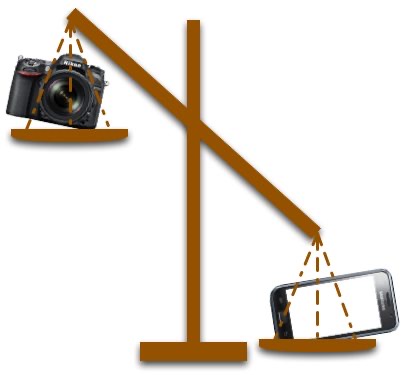(commentary)
Simple answer: yes.
Longer story: a reader recently sent me a panorama they made with their iPhone 6+ and lamented the fact that to do the same with their D800 required a lot of gear, a lot of careful setting, and a lot of time. Plus the iPhone was cheaper ;~).
The “good enough” problem is really eating away at the camera companies now. I think it’s going to be extremely important for them to understand whether the “good enough” versus “best possible” market splits are 80/20, 90/10, 95/5, 99/1, or worse. That’s because what you design and sell in the future is dependent upon understanding just where that line is.
We won’t have the final numbers until mid-February, but let’s make some wild guesses based upon the numbers we know through November:
- Total camera shipments: 45m units
- Total smartphone shipments: 1.3b units

That’s something akin to 96/4.
Of course, not all smartphones are bought to be used as cameras (nor are all cameras actually used ;~). Still, it gives us a starting place for the discussion: in all likelihood, the only camera purchasers still left are those that want “best possible.”
Which makes products like the Canon Rebel T5i and Nikon D3300 seem a bit anachronistic. Those cameras are certainly “best possible” when compared to a smartphone, but they’re also stripped down models to the crowd that’s actually most interested in “best possible.” [Update: a number of people seem to have missed the words “a bit” before the "anachronistic.” Sure, there’s still room for an “entry level best possible” camera: you have to jump from a smartphone to something, and it’s unrealistic to think that you jump from an iPhone 6 to a D810. But there’s less jumping happening into entry DSLRs now than previously, and a more logical jump would be to a good mirrorless camera anyway.]
In the past couple of years I’ve seen the “viral” dialog change a bit in terms of cameras. The new cameras that get viral or near-viral types of response on the Internet are far higher end than they used to be.
Take Sony, for example. The A6000 is a darned good camera. Excellent sensor, very good focus performance, pretty much everything you’d need in a camera, plus small, light, and not very expensive. Did it go viral? Not really. Instead, the A7 models went very viral. Excellent sensors, sure, but only okay focus performance, plus bigger, heavier, and more expensive!
Basically, the aspirations of those remaining in the room willing to discuss photographic gear ad nauseum are all touting the highest end products. D810, D750, 7DII, A7s, A7II, even in the compacts: LX-100, for example. Workhorses or bargains need not apply.
Moreover, the measurebators are still in the room and extremely vocal: more pixels, more dynamic range, less noise, more resolution, and so on. This represents “best possible” on steroids. These folk aren’t satisfied with having the best imaging gear we’ve ever had (and by a wide margin); they want more. A lot more.
If the camera companies are listening to these very few folk, they’re going to design full frame, 50+mp cameras with deeper dynamic range, and lenses that fully match them.
So what’s wrong with that? One thing: it’s a very small market.
The High Fidelity makers discovered this the hard way. Far too many folk stopped buying the minute they had something that they felt was good enough for their needs. Only a smallish group of die-hard audiophiles kept buying, and they bought only the top end. For them to buy, the new thing had to be demonstrably better than their current thing. Things got so ridiculous that some started hearing things that weren’t probably there. (Note that I’m not dismissing “golden ears”, but that many who thought they had such ears were just imagining things, not actually discriminating them.)
What killed High Fidelity? Convenience. The only folks left buying were ones that would tolerate inconvenience for extremely small gains, and had the disposable income to do just that. I used to have a large collection of records and 1/4” tapes. Today, everything I listen to is managed by a piece of software on my computer and available on any listening system I own on demand. While I keep my rip levels high, it’s “good enough” and the convenience is overwhelming.
Some of you wonder why I keep harping about workflow. Now you know: convenience will eventually win the market, even the high end. Indeed, that’s why it’s already winning with smartphones. Yet answer me this: what camera company in 2014 made any significant improvement in digital camera workflow?
Bueller?
Bueller?
Ferris Bueller?
Right. There’s no one answering my question.
If Canon wants to sell a Rebel 7Ti or Nikon a D4000, they’d better solve the convenience issue. From planning to output, the camera should be helping you do the work you need for your imaging. Today, the camera isn’t really involved in either of those things. What do I mean? Well, I’m off on a trip to Fiji, why can’t I tell my camera that I’m going to be in Fiji and to label images that way (e.g. FijiVacation2015_0001.JPG?). Likewise, why I can’t I post my images to email or someplace on the Internet directly from the camera, even if that requires it connect to and use an intermediary, such as my smartphone?
Nope. Camera makers think that cameras exist only to take photos. Everything else is your problem. Which is why you post your vacation photos from your smartphone. QED. Checkmate. Game over.
Let’s hope a camera maker addresses this, even modestly, in 2015. It would show that they understand the problem, at least. Right now, they simply don’t understand the problem, and thus, are never going to solve it. Good enough always wins out, but cameras, ironically, aren’t actually good enough in the ways that would make a difference to customers.





